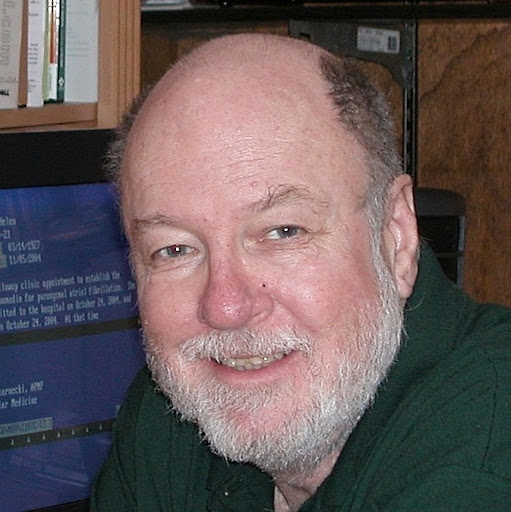Michael F Mckenney
age ~82
from Allyn, WA
- Also known as:
-
- Michael Fred Mckenney
- Mike F Mckenney
- Michael Mc Kenney
- Phone and address:
-
30 E Fairway Dr, Allyn, WA 98524
3602755285
Michael Mckenney Phones & Addresses
- 30 E Fairway Dr, Allyn, WA 98524 • 3602755285
- 590 E Island View Rd, Grapeview, WA 98546 • 3604260343
- Anaheim, CA
- Santa Ana, CA
- Manson, WA
Resumes

Michael Mckenney
view source
Michael Mckenney
view source
Michael Mckenney
view sourceUs Patents
-
Parallel Frequency Searching In An Acquisition Correlator
view source -
US Patent:6466958, Oct 15, 2002
-
Filed:Sep 12, 2000
-
Appl. No.:09/659517
-
Inventors:Robert J. Van Wechel - Yorba Linda CA
Michael F. McKenney - Anaheim CA -
Assignee:Interstate Electronics Corporation, a division of L3 Communications Corporation - Anaheim CA
-
International Classification:G06F 1715
-
US Classification:708422, 375142, 375143, 375150, 375152
-
Abstract:An apparatus and method allow receivers to quickly acquire a pseudorandom noise signal. A receiver advantageously detects frequency shifts using a compact parallel process hardware implementation of a Discrete Fourier Transform (DFT). The simultaneous detection of multiple frequencies allows the receiver to search the frequency range of the transmitted signal in larger increments of frequency, thereby increasing the speed of acquisition. One receiver does not use coherent integration before computation of the transform and advantageously maintains a flat frequency response. The flat frequency response of the DFT circuit enables searching of multiple frequency offsets without CPU intensive processing to compensate for frequency response variations. A receiver can include a Doppler correction circuit, which permits correlation data with frequency shift in the code to be non-coherently integrated among relatively fewer addresses or tap positions in memory.
-
Simultaneous Computation Of Multiple Complex Number Multiplication Products
view source -
US Patent:6567833, May 20, 2003
-
Filed:Jul 26, 2002
-
Appl. No.:10/207712
-
Inventors:Robert J. Van Wechel - Yorba Linda CA
Michael F. McKenney - Anaheim CA -
Assignee:Interstate Electronics Corporation, a division of L3 Communications Corp. - Anaheim CA
-
International Classification:G06F 752
-
US Classification:708622, 708441
-
Abstract:An apparatus and method allow receivers to quickly acquire a pseudorandom noise signal. A receiver advantageously detects frequency shifts using a compact parallel process hardware implementation of a Discrete Fourier Transform (DFT). The simultaneous detection of multiple frequencies allows the receiver to search the frequency range of the transmitted signal in larger increments of frequency, thereby increasing the speed of acquisition. One receiver does not use coherent integration before computation of the transform and advantageously maintains a flat frequency response. The flat frequency response of the DFT circuit enables searching of multiple frequency offsets without CPU intensive processing to compensate for frequency response variations. A receiver can include a Doppler correction circuit, which permits correlation data with frequency shift in the code to be non-coherently integrated among relatively fewer addresses or tap positions in memory.
-
Correction Of Code Drift In A Non-Coherent Memory
view source -
US Patent:6643678, Nov 4, 2003
-
Filed:Jul 26, 2002
-
Appl. No.:10/207425
-
Inventors:Robert J. Van Wechel - Yorba Linda CA
Michael F. McKenney - Anaheim CA -
Assignee:Interstate Electronics Corporation, a division of L3 Communications Corporation - Anaheim CA
-
International Classification:G06F 1100
-
US Classification:708530, 375150
-
Abstract:An apparatus and method allow receivers to quickly acquire a pseudorandom noise signal. A receiver can include a Doppler correction circuit, which permits correlation data with frequency shift in the code to be non-coherently integrated among relatively fewer addresses or tap positions in memory. One receiver includes a Doppler offset generator that can advantageously offset a time index used to address a tap position in a non-coherent memory to compensate for code drift in a code with a frequency offset. The amount of offset is computed by accumulating clock cycles of a clock signal that is related to the frequency offset computed by the DFT or FFT frequency bin. The offset aligns a correlation peak in the received code such that the correlation peak can be accumulated in relatively fewer tap positions or addresses.
-
Multi-Pass Frequency Hop-Acquisition Correlator
view source -
US Patent:7092429, Aug 15, 2006
-
Filed:Sep 26, 2002
-
Appl. No.:10/256258
-
Inventors:Michael F. McKenney - Anaheim CA, US
-
Assignee:Interstate Electronics Corporation - Anaheim CA
-
International Classification:H04B 1/69
H04B 1/707
H04B 1/713 -
US Classification:375132, 375343, 375367, 708403, 708404, 708405, 708422
-
Abstract:A multi-pass frequency hop timing acquisition correlator that produces a more accurate time estimate from the fast acquisition frequency hop signal is disclosed. The time estimate produced by the multi-pass acquisition correlator is more accurate than the hop estimate produced by single-pass fast acquisition correlators. The multi-pass frequency hop timing acquisition correlator uses a time estimate generated by a previous pass through the multi-pass frequency hop timing acquisition correlator as a starting point for computing a new, more accurate, time estimate. Thus, the second pass through the multi-pass frequency hop timing acquisition correlator produces a time estimate that is relatively more accurate than the time estimate produced by the first pass. The more accurate time estimate produced by the multi-pass acquisition correlator reduces the hardware and time needed by the direct acquisition process to acquire the M-code. In one embodiment, the multiple-pass frequency-hop correlator on the second or third pass provides microsecond-level timing from a GPS M-code fast acquisition frequency hop signal in a jamming environment.
-
Systems And Methods For Extracting Coherent Correlation Data
view source -
US Patent:7185038, Feb 27, 2007
-
Filed:Aug 29, 2003
-
Appl. No.:10/651895
-
Inventors:Robert J. Van Wechel - Yorba Linda CA, US
Michael F. McKenney - Anaheim CA, US -
Assignee:Interstate Electronics Corporation - Anahiem CA
-
International Classification:G06F 17/15
H04B 15/10 -
US Classification:708422
-
Abstract:An apparatus and method allow receivers to quickly acquire a pseudorandom noise signal. A receiver advantageously detects frequency shifts using a compact parallel process hardware implementation of a Discrete Fourier Transform (DFT). The simultaneous detection of multiple frequencies allows the receiver to search the frequency range of the transmitted signal in larger increments of frequency, thereby increasing the speed of acquisition. One receiver does not use coherent integration before computation of the transform and advantageously maintains a flat frequency response. The flat frequency response of the DFT circuit enables searching of multiple frequency offsets without CPU intensive processing to compensate for frequency response variations. A receiver can include a Doppler correction circuit, which permits correlation data with frequency shift in the code to be non-coherently integrated among relatively fewer addresses or tap positions in memory.
-
Systems And Methods For Extracting Coherent Correlation Data
view source -
US Patent:7870178, Jan 11, 2011
-
Filed:Feb 27, 2007
-
Appl. No.:11/679755
-
Inventors:Robert J. Van Wechel - Yorba Linda CA, US
Michael F. McKenney - Anaheim CA, US -
Assignee:Interstate Electronics Corporation - Anaheim CA
-
International Classification:G06F 17/15
H04B 1/00 -
US Classification:708422, 375150
-
Abstract:An apparatus and method allow receivers to quickly acquire a pseudorandom noise signal. A receiver advantageously detects frequency shifts using a compact parallel process hardware implementation of a Discrete Fourier Transform (DFT). The simultaneous detection of multiple frequencies allows the receiver to search the frequency range of the transmitted signal in larger increments of frequency, thereby increasing the speed of acquisition. One receiver does not use coherent integration before computation of the transform and advantageously maintains a flat frequency response. The flat frequency response of the DFT circuit enables searching of multiple frequency offsets without CPU intensive processing to compensate for frequency response variations. A receiver can include a Doppler correction circuit, which permits correlation data with frequency shift in the code to be non-coherently integrated among relatively fewer addresses or tap positions in memory.
Classmates

Michael McKenney
view sourceSchools:
North Kent Alternative High School Comstock Park MI 1987-1991
Community:
Sharon Brockman, Madison Pitcher, Dawn Mcgowan, Cherri Wilkerson

Michael McKenney
view sourceSchools:
Don Juan Avila Middle School Aliso Viejo CA 2003-2007
Community:
Michelle Soto

Michael McKenney
view sourceSchools:
Council Rock High School South Holland PA 2004-2008

Michael McKenney
view sourceSchools:
St. Mary's Academy Dover NH 1973-1977
Community:
Scott Moore, David Keenan

Michael McKenney
view sourceSchools:
Lee High School Wyoming MI 1983-1986, North Kent Alternative High School Comstock Park MI 1987-1990
Community:
Robert Dalziel, Markco Velazquez, Scott Vansickel

Michael McKenney
view sourceSchools:
Crowland Central Public School Welland Morocco 1989-1998
Community:
John Yanyshyn, Jim Gallinger

North Kent Alternative Hi...
view sourceGraduates:
Rafael Hernandez (1995-1999),
Michael McKenney (1987-1991),
Bleh Wibble (1991-1995),
Jon Blaszczyk (1995-1999)
Michael McKenney (1987-1991),
Bleh Wibble (1991-1995),
Jon Blaszczyk (1995-1999)

Syracuse University - Man...
view sourceGraduates:
Rod Severance (1980-1982),
Bill Danigelis (1982-1986),
Michael McKenney (1964-1966),
Jennifer Fischer (1987-1991)
Bill Danigelis (1982-1986),
Michael McKenney (1964-1966),
Jennifer Fischer (1987-1991)
Googleplus

Michael Mckenney
Education:
University of Detroit Mercy - Electrical engineering

Michael Mckenney
Work:
Self-employed - Certified Medical Transcriptionist
Relationship:
Married

Michael Mckenney

Michael Mckenney

Michael Mckenney

Michael Mckenney

Michael Mckenney

Michael Mckenney
Myspace
Youtube
Plaxo

MICHAEL MCKENNEY
view source
Michael Kyon McKenney
view source
Michael Mckenney
view source
Michael McKenney
view source
Michael McKenney
view source
Michael Mckenney
view source
Mike Mckenney
view source
Michael McKenney
view source
Michael McKenney
view sourceGet Report for Michael F Mckenney from Allyn, WA, age ~82










